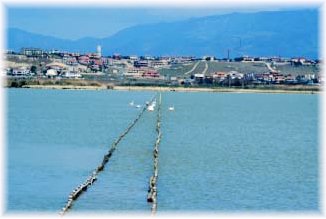They used to be synonymous with malaria and were considered barren areas, but now that large scale reclamation operations have drastically reduced the number of these environments with their special ecosystem, these areas are now safeguarded and protected.
What makes them interesting isn't so much their appearance, which is undoubtedly suggestive, but the role they play in maintaining the hydrogeological and climatic balance which characterises them. In fact, they act, in the case of floods, as basins and reserves of water supplies which continuously supply the subterranean waters and can reduce sudden changes in temperature in nearby areas.
These special ecosystems also play a very important role in the evolution of the species, because they allow plant and animal species which would barely survive elsewhere to live. They are the perfect place for local birds to nest and provide safe and comfortable stopovers for migrating birds.
Among the positive aspects of the marsh lands is that of being one of the most fertile areas in the world, partly because of the constant movement of tidal waters which encourages the movement of food substances and also for the countless plant species that live and grow there, thus increasing photosynthesis and the penetration of solar energy. All these elements allow for a remarkable variety of life at every level.
The natural formation of these areas dates back to around a billion years ago when the oceans began to recede. Over the years many marshy areas have been transformed, drained and made suitable for cultivation. The Etruscans and the Romans were real masters in this field, carrying out land reclamation known as "natural drainage", which exploited even the slightest downward slope in the land to allow the water collected in ditches to drain off to the sea.
In Tuscany (a region which over the course of the centuries has made great use of reclamation operations) the reclamation of large areas of ground began in the 15th century continuing on until the 19th century (under Lorraine rule) to the extent that many areas which were marshy and unhealthy were completely transformed into some of the most fertile parts of the region.
In the valley between the mountains of Campiglia and the Piombino promontory, the lengthy draining works reduced the marsh grounds from 1,500 hectares to around a hundred.
One reminder of the old fenlands is the Marsh of Orti di Bottagone considered to be an area of enormous environmental importance where, in different areas quite close one to the other, there are plant groups typical of salt water environments (made up of small plants with a fleshy consistency) and fresh water species (ditch reeds, water lilies).

Molentargius pond in Sardinia (photo Blue Planet©)
Among all the 214 notable marshland areas in Italy (6 million hectares) the ponds at Cagliari really are an El Dorado for many animal (and ornithological) species. One is Molentargius (at Quartu S.Elena to the east) where thousands of flamingoes and avocets nest. Then there is Capoterra (west of Cagliari) which offers sanctuary to wild ducks, pink gulls, red-crested pochards and stilt-birds to name but a few.
